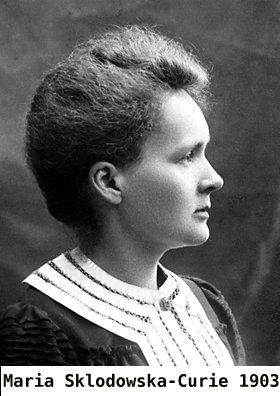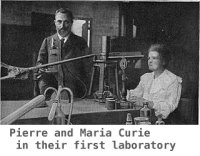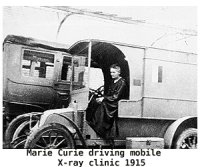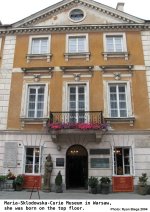

100 years ago, October 1911, the Nobel Prize for Chemistry was awarded to Marie Skłodowska - Curie for her discovery of two new radioactive elements, that she named Radium and Polonium. It is specially remarkable because this was the first time the Nobel Prize had been awarded twice to one person;
In 1903 she had shared the Prize for Physics with her husband Pierre Joliot and Henri Becquerel, for the discovery of radio-activity, and at the same time became the first woman Laureate.
 In fact only three other individuals have ever received two Nobel prizes, and no one else has ever received Prizes for two different sciences. Among other firsts - she was the first woman to pass the entry examinations for doctorate studies at the Sorbonne, the first woman to receive a PhD in Chemistry (1903) and then in Physics (1904), the first woman to be admitted to teach as a full professor at the Sorbonne (1906). Also remarkable - her daughter Irene Joliot-Curie received the Nobel Prize for Chemistry in 1935, together with her husband Frederic Joliot. Her grandchildren, Helene Langevin-Joliot and Pierre Joliot are also renowned scientists in the nuclear and biology fields.
In fact only three other individuals have ever received two Nobel prizes, and no one else has ever received Prizes for two different sciences. Among other firsts - she was the first woman to pass the entry examinations for doctorate studies at the Sorbonne, the first woman to receive a PhD in Chemistry (1903) and then in Physics (1904), the first woman to be admitted to teach as a full professor at the Sorbonne (1906). Also remarkable - her daughter Irene Joliot-Curie received the Nobel Prize for Chemistry in 1935, together with her husband Frederic Joliot. Her grandchildren, Helene Langevin-Joliot and Pierre Joliot are also renowned scientists in the nuclear and biology fields.
She never lost her sense of Polish identity. Confusion occurred when sometimes she signed her name Curie-Skłodowska (reversing the sequence). She taught her daughters the Polish language and took them on visits to Poland. She named the first chemical element that she discovered "polonium" (1898) for her native country. During World War I she became a member of the Committee for a Free Poland (Komitet Wolnej Polski). In 1932 she founded a Radium Institute (now the Maria Skłodowska-Curie Institute of Oncology) in her home town, Warsaw, headed by her physician-sister Bronisława.
Maria Skłodowska was born in Warsaw 7 November 1867 at 16 Freta Street in Warsaw, youngest of the 5 children of Władysław Skłodowski, a teacher of physics and mathematics in schools for boys in Warsaw. Both her father's and mother's families had lost all their properties as a result of participation in uprisings against the occupying Russians. Consequently they were impoverished, and were living on the top floor of the house, which was a residence for school-girls from the country, managed by her mother.
She received her high school diploma with gold medal for excellence in mathematics in 1883 at the age of 16. She then worked as a governess to help finance the studies of her older sister Bronia at medical school in Paris. Bronia promised to bring Maria to Paris as soon as possible, so that she could study there too. In the meantime Maria took night courses to get the additional education in chemistry, mathematics and physics that she would need to pass entrance examinations to Paris University, Sorbonne.
Finally in 1891 she was on her way. In 1893 she graduated at top of her class in physics and the following year second in mathematics. She was introduced to Pierre Curie, a physicist, by mutual friends. Working together in a laboratory at the school where he was an instructor, they fell in love, and in 1895 were married.
That same year Wilhelm Roentgen had discovered that a cathode-ray tube emitted rays that penetrated many substances. He called them X-rays and was awarded a Nobel prize for this discovery. The following year Henri Becquerel found that the salts of uranium, used for adding color to glass, emitted radiations affecting photographic plates and, like the X-ray, passed through many substances impervious to ordinary light.
 Marie Skłodowska-Curie decided to use this new discovery of radioactivity for her doctorate thesis. She used an electrometer, developed by her husband and his brother Jacques, to measure the faint currents that can pass through air that has been bombarded with radioactive rays. After determining that salts of thorium also exhibited the same properties as uranium. Then she observed that samples of pitchblende from which the uranium had already been extracted, were much more radioactuve than uranium itself and concluded that there must be another element present. The Austrian government provided her with a ton of pitchblende from a mine in Bohemia (now Czech Republic) from which the uranium had already been extracted. Pierre abandoned his own work and joined her in her research. After a year of hard physical labor she revealed that the sources of this radioactivity were two previously unknown elements, which she named Polonium and Radium, and established their atomic weights. They were announced in two papers presented at the Academie des Sciences in July and December 1898. They then continued their work to isolate sufficient quantities to establish their properties. After several years they succeeded in isolating a few milligrams of pure radium. Polonium was only seen in compounds.
Marie Skłodowska-Curie decided to use this new discovery of radioactivity for her doctorate thesis. She used an electrometer, developed by her husband and his brother Jacques, to measure the faint currents that can pass through air that has been bombarded with radioactive rays. After determining that salts of thorium also exhibited the same properties as uranium. Then she observed that samples of pitchblende from which the uranium had already been extracted, were much more radioactuve than uranium itself and concluded that there must be another element present. The Austrian government provided her with a ton of pitchblende from a mine in Bohemia (now Czech Republic) from which the uranium had already been extracted. Pierre abandoned his own work and joined her in her research. After a year of hard physical labor she revealed that the sources of this radioactivity were two previously unknown elements, which she named Polonium and Radium, and established their atomic weights. They were announced in two papers presented at the Academie des Sciences in July and December 1898. They then continued their work to isolate sufficient quantities to establish their properties. After several years they succeeded in isolating a few milligrams of pure radium. Polonium was only seen in compounds.
The results of their work and the award of the Nobel prize in 1903 for their work on the radiation previusly discovered by Bequerel (shared in half of the Prize) changed their life.
Pierre was finally appointed to a professorship at the Sorbonne, and the university belatedly found funds for a laboratory for him. It also hired Marie as head of the laboratory. They could also hire help for continuing research, particularly into the use od radioactivity in medicine.
Incidentally Marie had given birth to two daughters, Irene (1897) who also became a Nobel Laureate, and Eve (1904) who became a writer, journalist and pianist.
On a rainy day, April 19, 1906, Pierre Curie fell under a cart on a slippery street and was killed instantly. After this tragedy, the Sorbonne overcame its misogyny and appointed Marie to the position of full professor of physics. After receiving her second Nobel Prize in 1911, Marie devoted the rest of her life to establishing a Radium Institute, first in France, then in the 1930s in Poland. After overcoming many obstacles, the University of Paris and the Pasteur Foundation provided the funding for the building of the Radium Institute in 1909. Donations from philantropists, including Andrew Carnegie and Henri Rotschild, also assisted. The building completed in 1914, is now the Curie Museum. The Radium Institute became the Curie Institute after World War II and is now housed in several buildings in and around Paris, employing over 3000 scientists and physicians, devoted to research in physics, chemistry and medicine, with particular attention to radioactivity and cures for cancer.
 During World War I, Marie established a fleet of mobile radiation stations to help treat wounded Allied soldies. She also trained several hundred young women to work as X-ray technicians behind the front lines.
During World War I, Marie established a fleet of mobile radiation stations to help treat wounded Allied soldies. She also trained several hundred young women to work as X-ray technicians behind the front lines.
In the spring of 1920, Mrs William Brown Meloney, an American journalist, interviewed Marie Curie at her Paris laboratory. During this meeting, Mrs Meloney learned that what Marie wanted most was some additional radium, so that she could continue her laboratory research. She had not patented her method of extracting radium from pitchblend ore. Therefore she gained no financial reward when commercial companies started producing it. Now she could not afford to purchase any.
Mrs Meloney organized a fund raising drive in America, and in 1921 arranged a trip to America for Marie and her two daughters. Marie, a very modest and shy woman, who devoted her entire life to her work, was overwhelmed by the reception she received, in New York and other cities, and at numerous universities. Fortunately her daughters Eve and Irene, now 16 and 23 years old, were able to aid her and represent her when she felt too tired or ill.
 At the White House, Pres. Harding presented her with a lead-lined mahogany box containing one gram of Radium (then valued at approx. $100,000) as a gift from American women to assist in her research.
At the White House, Pres. Harding presented her with a lead-lined mahogany box containing one gram of Radium (then valued at approx. $100,000) as a gift from American women to assist in her research.
In 1929 she visited the USA a second time and visited the White House. Pres. Herbert Hoover presented to her a bank draft for $50,000 to purchase 1 gram of radium for the Radium institute of Poland in Warsaw, which had been established by her. Note that in 8 years the price of radium had decreased because of a new source in what was then the Belgian Congo.
Becoming increasingly frail and ill as a result of continous exposure to radioactivity, Marie Skłodowska - Curie died July 4, 1934. from aplastic pernicious anemia. Until the end of her life she remained a shy and modest woman who used none of her awards or grants for personal gain. For example, at the reception at the White House in 1921, she wore the same dress in which she had received the Nobel Prize 10 years earlier, she did not possess any other appropriate dress!
In 1995, by an act of the French parliament, The bodies of her and her husband were reburied in the Pantheon, the mauseleum of the great French, which include Rousseau, Monnet, Voltaire, Hugo.
Return to top of page.
Go to Home page
For a PRINTABLE VERSION OF THIS DOCUMENT
Click on Print
Biography of Maria Sklodkowska-Curie,
with links to some papers written by her.
Winter 2002 issue of 21st Century magazine tribute to Marie Sklodowska-Curie, with detailed description of her work and visits to USA in 1921 and 1929.
Bibliographie de M-me Marie Curie en français.
Radium, and Polonium. All about the highly radioactive elements discovered by Marie Sklodowska-Curie.
